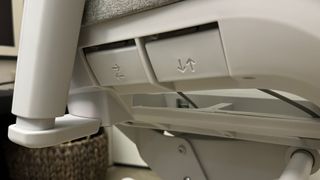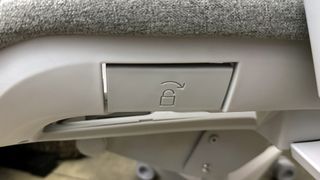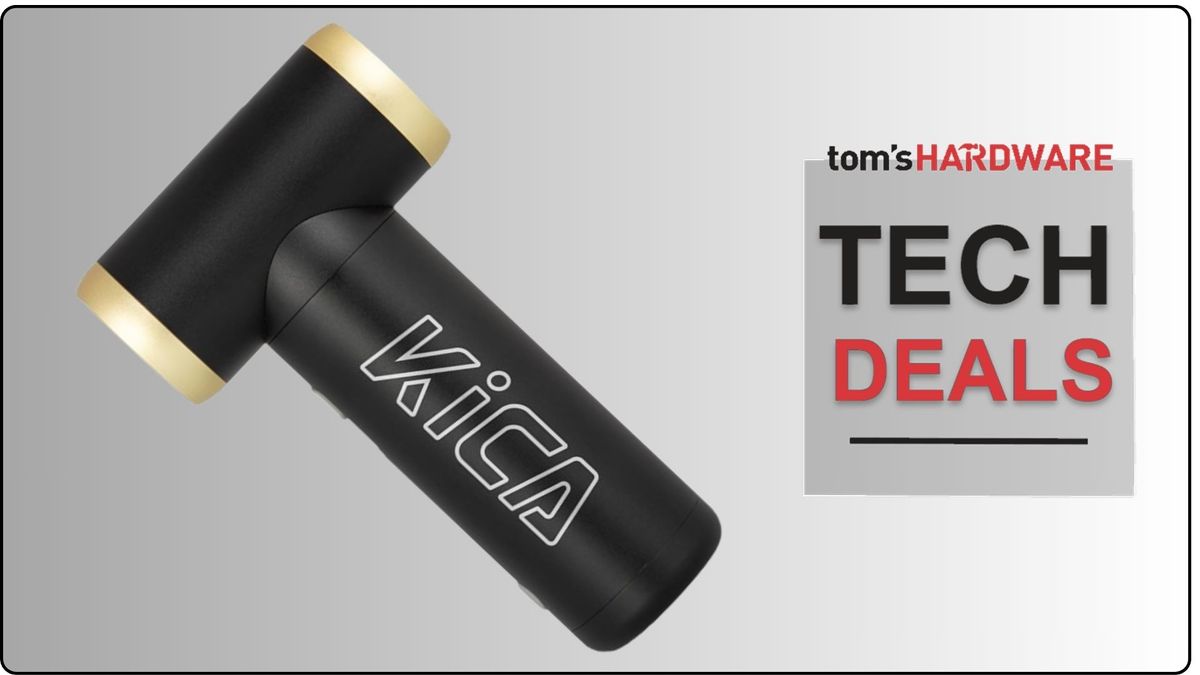Fractal Design is a PC hardware company best known for its cases — including our favorite mid-century modern wood case, the Fractal Design North. But this year the company has decided to branch out into furniture with its first-ever gaming chair, the Fractal Refine.
The Refine is surprisingly comfortable and... refined... for a gaming chair — though perhaps this shouldn't be too surprising, given Fractal's roots in Scandinavian aesthetics. The chair comes in both fabric and mesh versions and is still vaguely shaped like a gaming chair, but without all the aggressive racing / bucket-seat styling. It features 4D armrests, adjustable lumbar support, a removable headrest, and a tilt feature rather than "true" recline. It costs $549 for both the fabric and mesh versions (there's also an Alcantara fabric version that comes in at $899), and comes with a 5-year warranty on mechanical parts and a 3-year warranty on soft parts (upholstery, headrest, armrest pads, lumbar support pad).
We're big fans of gaming chairs that take inspiration from the office/task chair side, and the Refine definitely blurs the line.
Assembly of the Fractal Refine
The Refine requires some assembly, though it comes in a box that's big enough to make you wonder why they didn't just ship it fully assembled. The chair is well-packed, and the box contains all the accessories, parts, and tools needed for assembly, as well as an instruction booklet/user guide.

Assembling the Refine is pretty straightforward — it took me less than a half-hour to assemble by myself. The instructions are illustrated and walk you through the steps: attaching the casters and gas lift to the wheel base, placing the seat on top of the gas lift, and attaching the armrests and backrest to the seat with the included mounting screws.

The armrests attach with three screws and the mounting points allow for about an inch of width adjustment. The backrest attaches with four screws, two of which are pre-mounted and designed to slide easily into the seat bracket (you'll need to tighten these once it's in place).

The final piece is the memory foam neck pillow, which snaps into two notches on the Refine's headrest. The headrest moves vertically and can be removed by pressing the button on the top of the chair.
While the Refine is not a particularly lightweight chair — it weighs 78.7 pounds (35.7kg) fully assembled, which puts it in the same weight range as heavier racing-style gaming chairs, such as the Secretlab Titan Evo 2022 (76.1lbs / 34.5kg, regular) and the Thermaltake Argent E700 (68lbs / 30.8kg) — none of the individual parts were too large or unwieldy for me, working alone. This is probably because the backrest is primarily mesh (or fabric), not foam — the backrests of both the Titan Evo 2022 and the Agent E700 are quite a bit heavier and can be tricky to attach (especially without scratching the Argent E700's polycarbonate shell) by yourself. You'll need a little space to unpack and assemble the Refine, but the chair is heavy enough that you'll probably want to assemble it close to its final destination (I didn't, and ended up having to haul an 80-pound chair across my apartment).
Specifications
Swipe to scroll horizontally
| Upholstery | Fabric / Mesh / Alcantara |
| Total Height (with base) | 52.76 - 57.68 inches / 1340 - 1465mm |
| Floor to Seat Height | 18.66 - 23.42 inches/ 474 - 595mm |
| Armrest Adjustments | 4D (height, width, depth, angle) |
| Recline | 130 degree tilt (under load) |
| Backrest Length | 34.45 inches / 875mm |
| Backrest Width (Shoulder Level) | 20.87 inches / 530mm |
| Seating Area Width (Point of Contact) | 17.13 inches / 435mm |
| Seating Area Width (total) | 21.26 inches / 540mm |
| Seating Area Depth | 16.73 - 18.9 inches / 425 - 480mm |
| Armrest Width | 16.54 - 22.05 inches / 420 - 560mm |
| Armrest Height | 6.3 - 10.63 inches / 160 - 270mm |
| Max Recommended Weight | 276lbs / 125kg |
| Weight | 78.7lbs / 35.7kg |
| Warranty | 5 years (mechanical parts), 3 years (upholstery) |
| MSRP | $549 - mesh, fabric; $899 - Alcantara |
| Release Date | Sept. 12, 2024 |
Design of the Fractal Refine
The Refine is a high-back fabric-and-mesh gaming chair with a vaguely racing-inspired silhouette. It comes in a couple of different upholstery options: "mesh" and "fabric," both of which come in light and dark variations and cost $549, as well as a dark Alcantara fabric option, which costs $899. We took a look at the mesh version of the Refine in the light colorway for this review.

The Refine sort of mixes the racing-style gaming chair aesthetic with mesh task chair ergonomics, and I don't hate it. It looks a lot better than Cooler Master's Hybrid 1, which features a similar hybrid gaming/task chair concept, but does not (in my opinion) execute it well. While the Hybrid 1 just sort of jammed a mesh backrest into a still very aggressively-styled racing frame, the Refine is a little more, well, refined. It still has a racing silhouette, with a backrest that flares out at shoulders, but it doesn't have anywhere near as much bucket-style bolstering as the Hybrid 1 (or other racing style chairs).
The mesh version of the chair has what is essentially an all-mesh design, with a mesh seat and a mesh backrest surrounded by a foam-bolstered fabric-covered frame. The fabric and Alcantara versions have a similar backrest (just with lightly padded fabric stretched over the frame instead of mesh) but have cold-cured foam seats. The light colorway is a light tan-gray, and while the combination of mesh and fabric-covered frame isn't exactly my favorite aesthetic, it's a pretty clean look and doesn't scream "gamer" at all. The wheel base, armrests, and the mounting points where the backrests and armrests attach to the seat base are all aluminum, while the rest of the frame is plastic with a 20 - 30% glass fiber fill.
The Refine is a fairly sturdy chair (it certainly weighs a lot), but Fractal's recommended weight limit is 276 pounds (125kg), which is on the lower side. For reference, the Vantum's weight limit is 350 pounds (159kg), and the Vantum is smaller and lighter than the Refine. Fractal also recommends a height range of around 5'5" - 6'7" (1.65 - 2m). I'm 5'7" and 130 pounds, and I do think this is a little too much chair for someone much smaller than me — the seat height was a tiny bit higher than I preferred, even at its lowest setting, and I couldn't get the tilt tension to go as low as I would have liked, so someone shorter and lighter than me would likely have some issues. I'm not sure why the upper weight limit is as low as it is — it's a pretty heavy chair with a sturdy frame — but I suspect it has something to do with the integrity of the mesh.

Speaking of, the mesh on this chair is... not great. I love mesh chairs — my primary chair is the Herman Miller Aeron — but the mesh on the Refine is not as tightly woven as the mesh on the Aeron or on the Steelcase Karman, and it has a plasticky, scratchy feel to it. This is definitely an issue if you're wearing shorts, and it's still a little uncomfortable even if you're not — I could feel the scratchiness of the mesh through leggings and sweatpants.
Scratchy mesh aside, I was surprised by how comfortable I found the Refine once I locked it into a slightly reclined tilt position. I'm usually eager to get back to my Aeron when I'm testing chairs, but I ended up sticking with the Refine for much longer than I thought I would — because it was comfortable enough that I had no issues, and because it was so heavy that I didn't want to move it (my office has a pretty narrow entryway, so some lifting is required to switch out chairs).
Comfort and Adjustments of the Fractal Refine
The Refine has one rotary lever (under the seat, on the right side) and three adjustment levers built into the seat base (two on the right, one on the left). The rotary lever controls the chair's tilt tension — rotating it forward increases tension, while rotating it backward decreases it. The lever is easy to reach and even pulls out for better access, but it didn't seem to do much in my testing. It's not notched, like the tension knob on the Herman Miller x Logitech G Vantum, so you'll need to play around with it a bit to find the right tilt tension for you.

Unfortunately, I couldn't find the right tilt tension — I like a pretty loose tilt in my task chairs, and the Refine felt stiff and upright no matter how much I turned the knob backward. I thought this would be a dealbreaker, as the Refine has a very upright, forward-leaning tilt in its default state (similar to the "active, forward-leaning alignment" on the Vantum). With the tall headrest, I almost felt trapped at the front of the chair. However, I was able to lock the chair in a slight recline, and I found that to be not just tolerable, but fairly comfortable.

The two levers built into the right side of the chair's seat base control height and seat depth. The front lever controls height and works as expected — pulling it raises and lowers the seat via the gas lift. The minimum floor-to-seat height on this chair is 18.66 inches (474mm). This felt slightly too high once you add in the thickness of the seat, but didn't cause any issues for me as the arm rests still lowered enough to go under my desk. The back lever controls seat depth, which can be adjusted from 16.73 inches (425mm) to 18.9 inches (480mm). While that's not a big difference, and might still be a little too shallow for some, it's nice to see any seat depth adjustment at all.

The lever built into the left side of the chair allows you to lock the chair's tilt angle. You pull the lever out to lock the current tilt position and push it back in to unlock the tilt. The chair tilts back 130 degrees under load (meaning you'll need to be sitting in it — it's not a "true" recline), and can be locked in position — upright to 130 degrees (there are 13 lockable steps). While I never quite got the tilt tension to be as loose as I wanted, I found that locking the chair in a slight recline made it much more comfortable for me.

The Refine also has a very nice built-in adjustable lumbar support system that presses through the backrest to provide plenty of lower-back support. The lumbar support can be adjusted up and down by manually sliding it in its frame. It also has a wheel that lets you adjust how much it presses into your back — turning the wheel counterclockwise makes it less prominent (turning it all the way to the left takes the pressure off completely) and turning it clockwise makes it more prominent. The lumbar support doesn't contour and mold to your back the way the support on the Vantum does, but it looks and feels like it belongs to a much pricier chair than the $549 Refine.

Like many gaming chairs, the Refine has 4D armrests: you can adjust the height, width, depth, and angle. Each armrest has three adjustment levers/buttons: a lever on the outside lets you adjust height, a button on the inside lets you adjust width, and a button on the inside near the front lets you adjust angle. There's no button or lever for adjusting depth; the armrest slides back and forth with a little pressure. The Refine's armrests need a little pressure to move — they're not clacking around every time you bump them, like the armrests on the Argent E700 — but it is annoying to not be able to lock them in place.
The armrests can be adjusted from a height of 6.3 inches (160mm) to 10.63 inches (270mm) above the seat, which is a wide enough range that they should be able to fit under most desks (at their lowest, they're just under 25 inches / 635mm) off the floor). They have lightly padded polyurethane tops with chamfered edges.

The headrest on the Refine is nicely implemented — it clicks into place and can be raised, lowered, or removed completely. It's moderately dense — made of fabric-covered memory foam — and designed to cushion your neck. It's not too different from what you'll find on chairs such as the Noblechairs Legend or the Secretlab Titan Evo 2022, but the attachment is more elegant than elastic straps and magnets. I did find it to be a little too high for me, even at its lowest point (but I also just don't really like headrests).
While I didn't have any glaring comfort issues with the Refine in my weeks of testing it, my husband did — though he liked the chair a lot when he first sat in it. My husband is taller than me (just under 6'), and weighs quite a bit more (around 180lbs), but he's still well within the recommended height/weight range set by Fractal for this chair. His primary issues were ones that did seem related to him being larger than me: the mesh, scratchiness, didn't give him enough support and seemed like it could sag over time. And leaning back in the chair caused the backrest to creak and sometimes caused the lumbar support to slip out of place.
Bottom Line
The Fractal Refine is a solid offering for the PC part maker's first foray into furniture. The chair retains the hallmarks of a "gaming chair" — a vaguely racing-style silhouette and myriad adjustments, including 4D armrests and a removable headrest — while adding a lot of premium touches typically found on task chairs, such as nicely-implemented adjustable lumbar support and "synchro-tilt" instead of carseat-style recline.
At $549 for the fabric and mesh versions, the Refine is priced lower than similar task chair-inspired gaming chairs, such as the $895 Herman Miller x Logitech G Vantum and the $899 Asus Destrier. But perhaps there's a reason for this — while I found the Refine to be comfortable, it did seem like it was built for someone slightly larger than me (the seat height and headrest were slightly too high at their lowest settings, and the tilt tension didn't seem to go low enough for me to easily lean back). But my husband, who is larger than me, felt like the chair was built for someone smaller than him, which means the chair is perhaps ideal for someone who is between 5'7" and 6' and weighs more than 130 pounds but less than 180 pounds — taht’s a pretty narrow range.

 4 days ago
7
4 days ago
7








 English (US) ·
English (US) ·